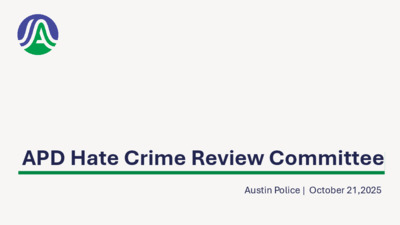Item 2: APD Hate Crime Review Committee — original pdf
Backup

APD Hate Crime Review Committee Austin Police | October 21,2025 Agenda ❖ What is a hate crime? • • Definition and legal considerations Hate crime vs hate incident ❖ How to report a hate crime? APD reporting methods • ❖ What happens after the hate crime is reported? • Overview of APD Hate Crime Review Committee ❖ Officer hate crime related training ❖ Hate crime support services APD Victim Services Unit • Definition and Legal Considerations ❖ Hate Crime: a criminal act committed against a person, or a person's property, that is motivated by bias against a person’s, or group’s, race, ethnicity, religion, color, disability, sexual orientation, gender identity, age, national origin or ancestry, or status as a peace officer or judge. ❖ Hate Crime is not a specific offense, but rather a penalty enhancement. ▪ Essentially a traditional crime with the added element of bias motivation. ❖ The penalty enhancement is decided by the trier of fact (judge or jury) at the guilt/innocence phase of the trial. ▪ APD doesn’t control whether or not an enhancement is applied. ▪ Recent example - last month the Travis County DA’s Office announced a hate crime finding related to a 2023 Terroristic Threat charge. ❖ Hate Crime versus a Hate Incident. ▪ Hate Incident: an act that is motivated by bias that does not rise to the level of a criminal offense. ▪ Law enforcement can’t infringe on 1st Amendment Right to freedom of speech. ▪ Example – handing out fliers with offensive language towards a particular group. 3 Hate Crime Reporting ❖ When to call 911: ▪ There’s an immediate danger to life or property. ▪ A crime is actively occurring. ▪ The suspect is still on scene. ❖ Secondary reporting methods: ▪ Austin 311 (512-974-2000) ▪ Online Reporting (iReport Austin) ❖ Detailed articulation is important! ▪ If the incident involves bias or prejudice, it’s important to provide all available details that may support a hate crime enhancement. 4 APD Hate Crime Review Committee ❖ Potential hate crimes are routed to both the investigative unit and the review committee for simultaneous review. ❖ The Committee consists of both civilian and sworn personnel. Non-Sworn Sworn Victim Services Manager 2 Civilians Lieutenant 2 Detectives ❖ Committee members meet monthly to review cases. • Did a criminal offense occur? • Was the motivation based on bias or prejudice? ❖ An affirmative finding results in notification to the prosecuting agency and reporting to the DPS. 5 Recent APD Hate Crime Statistics ❖ Total Hate Crime Reports: ▪ 2023: ▪ Total APD Reports = 143,479 ▪ Total Hate Crime Reports = 50 ▪ 2024: ▪ Total APD Report = 143,559 ▪ Total Hate Crime Reports = 57 ▪ 2025 (Sept): ▪ Total APD Reports = 115,790 ▪ Total Hate Crime Reports = 40 ▪ Hate Crime Reports make up ~.04% of APD Reports. ❖ Reports with an Anti-Asian bias: ▪ 2023 = 1 ▪ 2024 = 5 ▪ 2025 = 1 6 APD Hate Crime Training for Officers ❖ Cadets receive an 8-hour block of instruction on Multiculturalism and Human Relations ▪ Course Goals: • • • • • • • (1) Define multiculturalism and its key concepts. (2) Discuss impact of multiculturalism on law enforcement. (3) Highlight differences between cultural groups that may impact communication. (4) Recommend communication strategies to mitigate cultural differences and limit misunderstandings. (5) Differentiate between prejudice, types of bias, and discrimination. (6) Analyze the consequences of bias in law enforcement. (7) Highlight APD policy related to discrimination and hate crimes. ❖ ADL (Anit-Defamation League) provides “Hate Crimes Recognition for Law Enforcement” training for cadets and officers. ❖ AFSSA (Asian Family Support Services of Austin) talks with every cadet class about cultural competence regarding victims in the Asian and Asian American Communities 7 APD Victim Services ❖ Review all 311 service calls ❖ Make proactive outreach to potential victims. ❖ Review all police reports / incidents presented to the Hate Crime Committee ❖ Provide support to those affected by the incidents, whether a crime or not. ❖ Explain the investigative process 8 QUESTIONS? 9